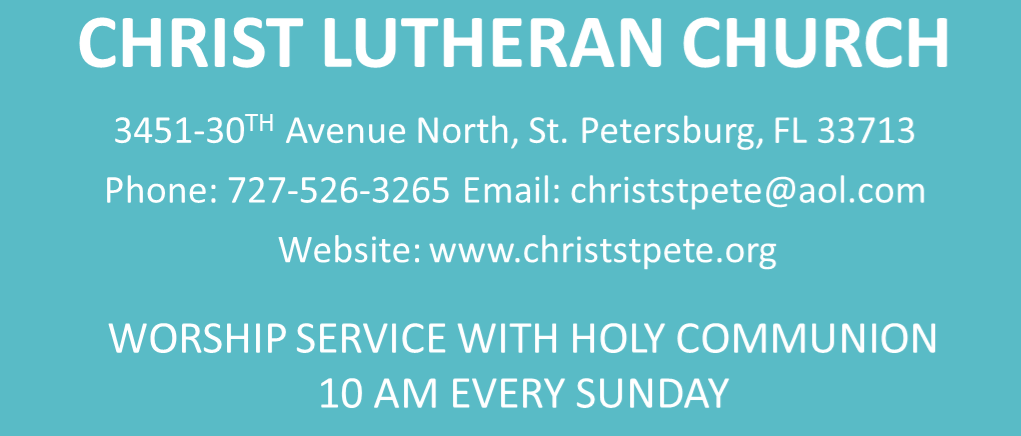Small Stained Glass Windows:
Our Small Stained Glass windows were brought over from our original sanctuary where they were used as Clerestory Windows.
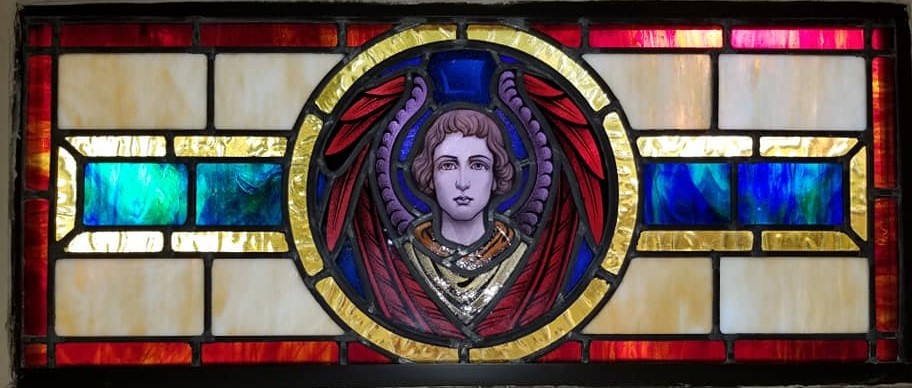
IS REPRESENTED AS A YOUNG MAN WITH WINGS
St. Matthew Window – This window on the west side of the Sanctuary represents St. Matthew writer of the first Gospel because St. Matthew’s Gospel focuses on the humanity of Christ. Matthew describes Jesus Christ’s life as a Jewish individual, participating in Jewish festivals and religious practices according to the Jewish Torah or Book of Laws, that we know as the first five books of the Old Testament. In this way, Jesus was gaining the trust of the Jews while fulfilling the prophecies of the long-awaited Messiah. The Gospel of Matthew is one of the Synoptic Gospels, along with the Gospel of Mark and the Gospel of Luke. The Gospel of Matthew was written for a mostly Jewish audience.
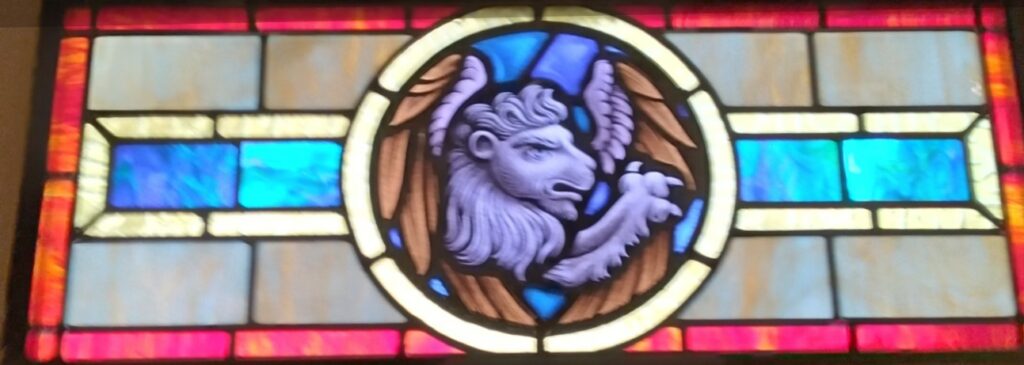
IS REPRESENTED BY A LION WITH WINGS
The Lion Window on the west wall of the Christ Lutheran Church Sanctuary represents St. Mark, writer of the second Gospel. The lion is used to represent St. Mark because Mark wrote about the Majesty of Jesus Christ, and lions are often used to represent royalty due to their powerful nature. The Gospel of Mark is the shortest, most concise of the four Gospels and is one of the three Synoptic Gospels.
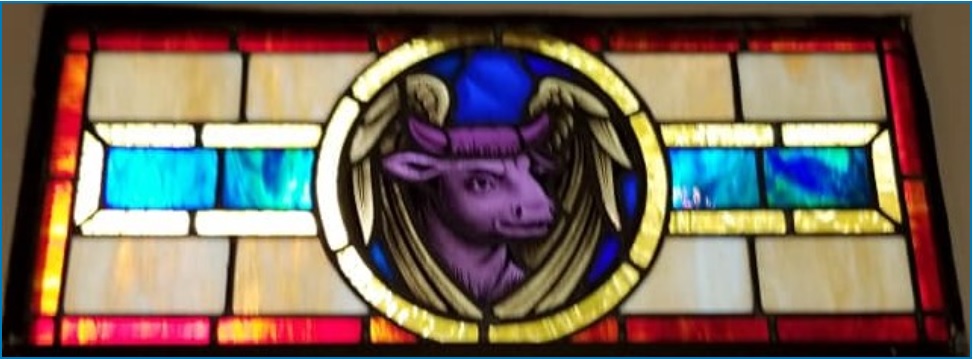
The Ox Window – on the west side of the Christ Lutheran Sanctuary represents St. Luke, writer of the third Gospel. St. Luke was a physician and a storyteller. He interviewed Mary, the mother of Jesus, about the Birth of Christ, giving us the Nativity Story in Luke 2. He traveled with St. Paul on St. Paul’s missionary journeys, and tells us what happened to the Apostles and their missionary work after the death and Resurrection of Jesus Christ in the Book of Acts, which is a sequel to the Gospel of Luke, and a chronology of the early Christian church in the first century A.D. The Gospel of Luke is the third of the Synoptic Gospels and emphasized the sacrifice and atonement given by Our Lord Jesus Christ. The Israelites used an Ox for their biggest sacrafice. The winged Ox shows that Christ’s sacrafice was a heavenly sacrifice, and Luke is a messenger of this sacrafice. We remember St. Luke on October 18th.
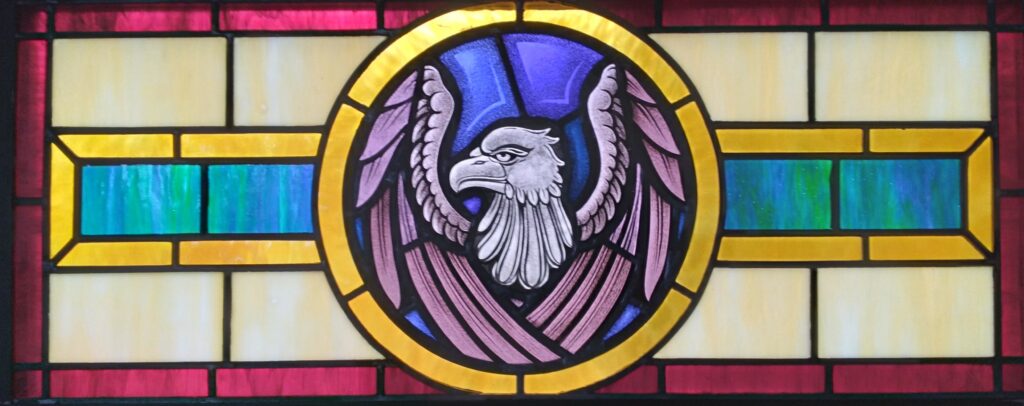
The Eagle Window on the west wall of the Christ Lutheran Church Sanctuary represents St. John the Evangelist, the “Eagle of Patmos”. St. John wrote the Gospel of John, three Epistles (John I, John II, and John III), and The Book of Revelation. He is said to have mentioned Love in his writings more than any other author of the Holy Bible. He is called an Eagle because of his ability to see things others could not. John wrote for an audience with eastern heritage and his writings tend to be cyclic rather than linear. John was the only writer of a Gospel who was not martyred and is said to have lived until at least 90 A.D.
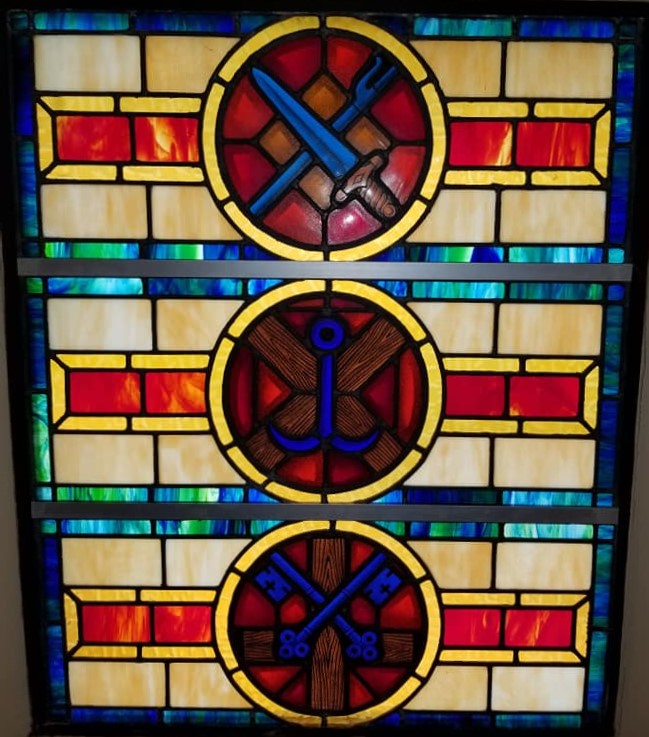
This group of windows represents three martyred Apostles:.
St. James the Greater, son of Zebedee, brother of John, is said to have traveled widely to preach the Gospel to many people. Tradition says he was beheaded for his missionary activities, hence the staff and sword as his symbol. His death is not recorded in the Holy Bible. St. James is remembered on July 25th.
St. Andrew is said to have died on an X shaped cross. He is remembered on November 30. The anchor relates to his occupation as a fisherman, and suggests our faith in Christ is the stabilizer of our problems in the rough sea of life. His cross is the national cross of Scotland, as well as the symbol for the beginning and the ending of the church year.
St. Peter requested that his cross be inverted as he felt he was not worth to die as Christ had died. Also, in that position, he could look heavenward as he was crucified by the Romans. Imposed on cross are crossed keys, In Matthew 16:19, Jesus promises to give Peter the Keys to the Kingdom of Heaven because of Peter’s strong faith in Jesus. Tradition says he was martyred in Rome; however, his death is not recorded in the Holy Bible. St. Peter is remembered on June 29th.
This group of windows represents three of Jesus Christ’s disciplines. The bottom window is for St. Peter, who Christ gave the Keys to the Kingdom because of his great faith.
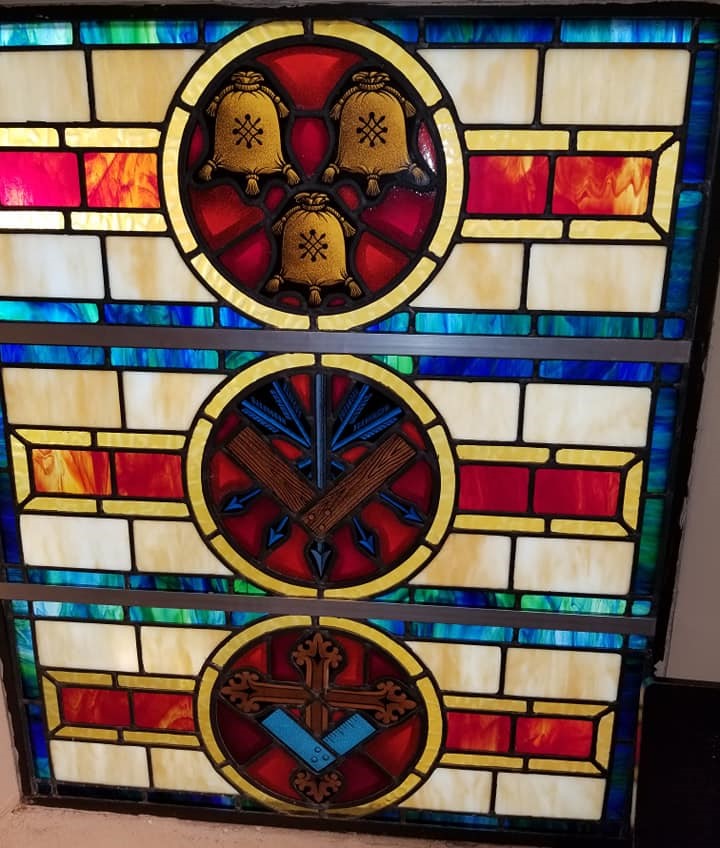
These four windows represent four important marks of Christian life.
The top window is a Censur, which is a symbol for Prayer. Psalm 141:2 states “Let my prayer be set forth before Thee as incense and a lifting up of my hands as the evening sacrafice.” Revelations 8;4 states “The smoke of the burning incense went up with the prayers of God’s people from the hands of the angel standing before God”.
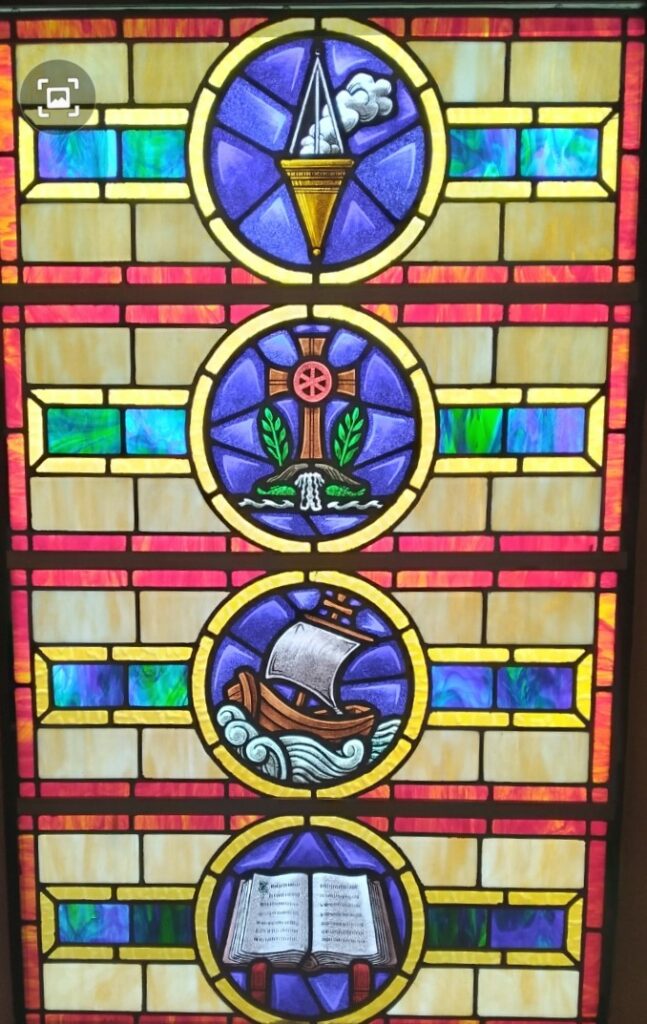
Blessed Sacraments – The Cross on the Rock from which living water flows symbolizes the blessings and gifts of God which flows constantly into the life of believers through Word and Sacrament. Revelations 22:17 states “Come, whoever is thirsty and accept the waters of life as a gift.”
The Ship – represents the Church with a cross and sails. As those from the Ark were saved from the flood, so the ship of the Church carries people to salvation. The water points towards Baptism. The Church sails through all perils. The Nave, the part of the Church where the congregation sits, comes from the Latin word for Ship.
Open Bible – The Word of God window reminds us that from God’s word, we learn the means of Grace and Salvation. Staying “in the Word” means hearing, listening, reading and studying the Bible so that the Scriptures can “speak” to us about staying close to and following Jesus. Matthew 13:9 states: “Let he who has ears, hear!” We all need to hear the words of Scripture in one way or another on a regular basis so we can stay close to and follow Jesus Christ, who is, as states in John 14:6 “the Way, the Truth and the Life.”
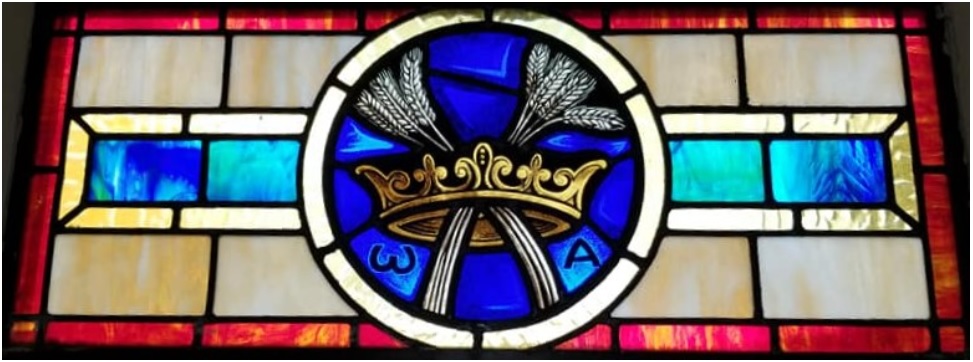
The Crown and Wheat Window – symbolizes the Harvest of the Lord. Wheat represents the faithful who are held within the crown of their reward. Revelations 2:10 promises “Be faithful unto death, and I will give thee the Crown of Life”. From inside the Christ Lutheran Sanctuary, we see the reversed symbols for Alpha and Omega. The window appears correctly from the outside of the Sanctuary. The window was likely inverted when transferred from the original sanctuary.
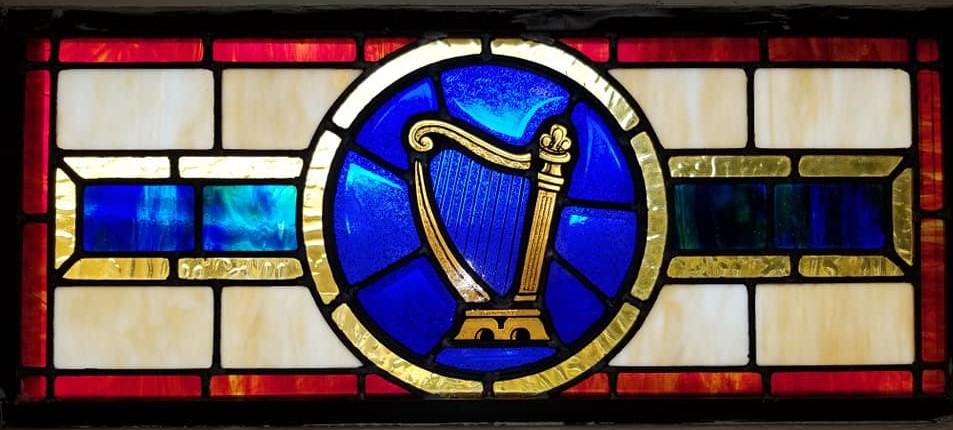
The Harp Window – reminds us of Music and its part in our worship. By playing the Harp or Lyre, King David soothed troubled King Saul. Revelations 14:2 states: I heard a voice from Heaven that sounded like a roaring waterfall, like the peal of thunder. It sounded like musicians playing their harps.” Today, the harp is occasionally used in worship, and is also one of the stops on some organs. Other forms of stringed instruments are common in many churches, including violins and guitars. Christ Lutheran Church has a violinist occasionally to play Special Music pieces. Our organist also plays the piano on a regular basis. The choir choose this symbol to be placed in the choir area of the Sanctuary at Christ Lutheran.
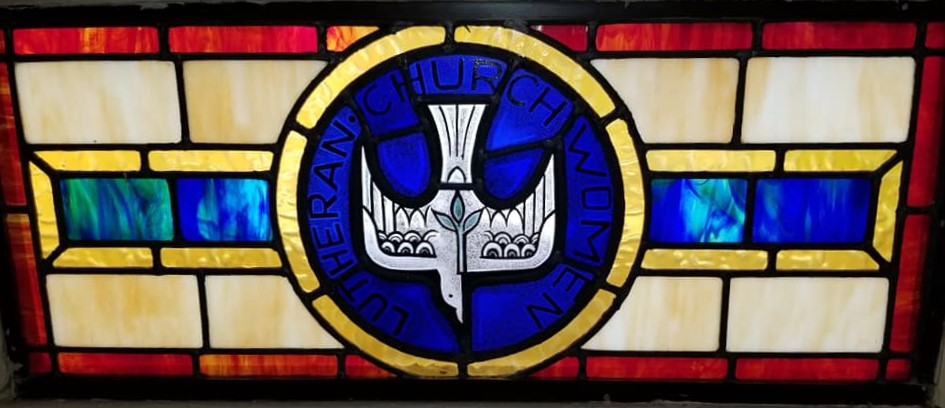
Dove window – The Dove is often used as a symbol of the Holy Spirit, and a Dove with an olive branch often symbolizes peace. It often expresses innocence and purity. Here it signifies the Presence of the God the Holy Spirit. It reminds us of the Baptism of Jesus Christ when the Holy Spirit came down like a Dove, and stated: “This is My Beloved Son in Whom I am Well Pleased” as recorded in Matthew 3:17. The Dove with an olive branch also reminds of us of Noah’s releasing of a dove which brought back a leaf, to indicate God had kept his promise of saving of the World. This window was donated by the a Lutheran Women’s Group active at the time of the purchase. Today, Christ Lutheran has a Women’s Bible Study group named “Women in the Spirit” which meets monthly.
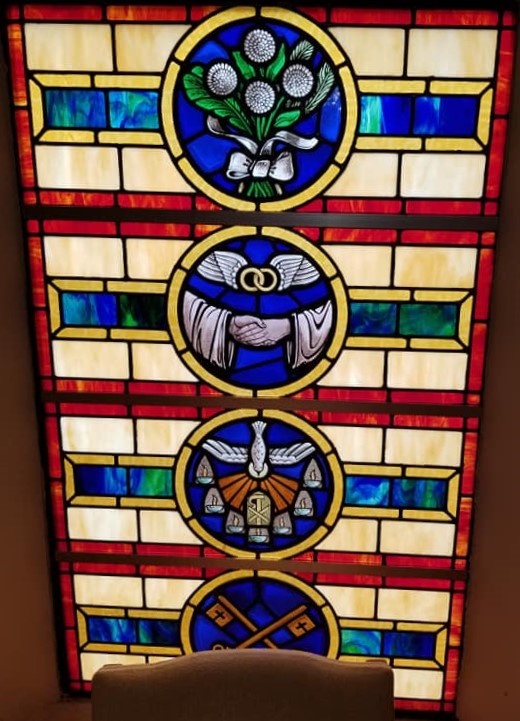
SYMBOLS OF GRACE WINDOW IN CHOIR AREA:
These four windows represent the means of God’s Grace:
Burial Elegy – the bouquet of four white flowers in a golden circle. Only white flowers were used on caskets in the early days, so the white flowers represent death and burial. The circle represents eternity, because it is without beginning or ending. Hence, in death, all can have eternal life. An elegy is a poem commemorating the dead, and this window is visual poetry.
Holy Matrimony – The blue cross in the background symbolizes Christ blessing the two wedding rings, symbols of the union of one man and one woman in marriage. Christ attended weddings during his life on earth and at the wedding feast at Cana, turned water into wine, as we read in the Gospel of John, Chapter 2. Christ wants us to have the best when we are married, and blesses our marriages.
Pentecost or Confirmation – the seven burning lamps are a reminder of the Holy Spirit descending as flames on the heads of the Apostles on the original Pentecost as described in the Book of Acts, Chapter 2, 1-11. Pentecost occurs 50 days after Easter. The seven flames also remind us of the seven lamps in the Book of Revelation, Chapter 4, Verse 5, which states: “In front of the throne, seven lighted torches were burning, which are the Spirits of God.” The Holy Spirit, shown as a Dove, gives light to the lamps, a light sent forth from Jesus Christ, who tells his Apostles in John 8:12: “I am the Light of the World”.
Keys – Crossed keys are the symbol for St. Peter, but also for our Shepherd and Pastor. The Office of the Keys is the power God gave to the Church to forgive or retain sins. Notice the tip of the keys have a cross while the handles have the three circles of the Holy Trinity. Matthew 16:19 records when Jesus states: “I will give you the Keys to the Kingdom of Heaven. Whatever you prohibit on earth, shall be prohibited in Heaven, but what you permit on Earth shall be permitted in Heaven.”
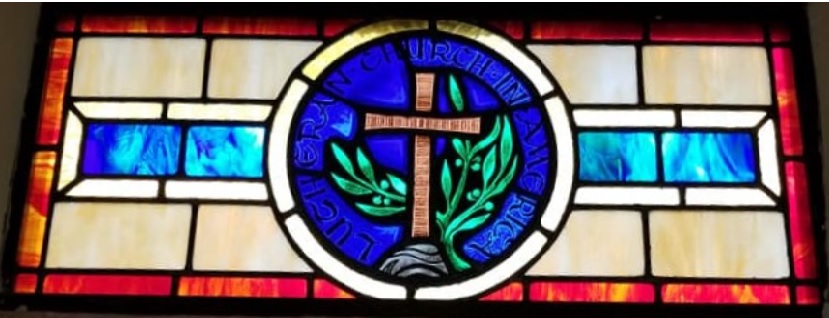
The Cross and Vines Window – represents the Church body Christ Lutheran belonged to when the window was purchased, the former Lutheran Church in America (LCA). When the LCA merged with the American Lutheran Church (ALC) in 1988 to form the Evangelical Lutheran Church in America (ELCA), Christ Lutheran became part of ELCA. Around 2000, the congregation of Christ Lutheran Church became dissatisfied with some of the new policies of the ELCA and a few years later, left the ELCA and joined first the Lutheran Churches in Mission to Christ (LCMC) and eventually the North American Lutheran Church (NALC). Christ Lutheran remains a member of both more conservative church bodies LCMC and NALC, and our Pastors belong to the Society of the Holy Trinity (STS). The design of the seal in the window comes from John 15:1-8, which states: “I am the true vine, ye are the branches. He who abidith in Me, and I in him the same, shall bringeth forth much fruit.” Here in this window, Our Lord, our source of Life and Salvation is symbolized in the Tree of Life (Revelations 2:7, and Revelations 22:2) and the Root of Jesse (Isaiah 11:1). The branches represent the faithful members of the Church, the Body of Christ. The leaves and fruit represent the productive life in Christ. The Cross, symbol of Redemption (Galatians 3:13) is rooted in the Tree, thus reminding us that Redemption comes from Christ Alone. Yet each of us must take up his own cross if we are to follow Him. Matthew 16:24
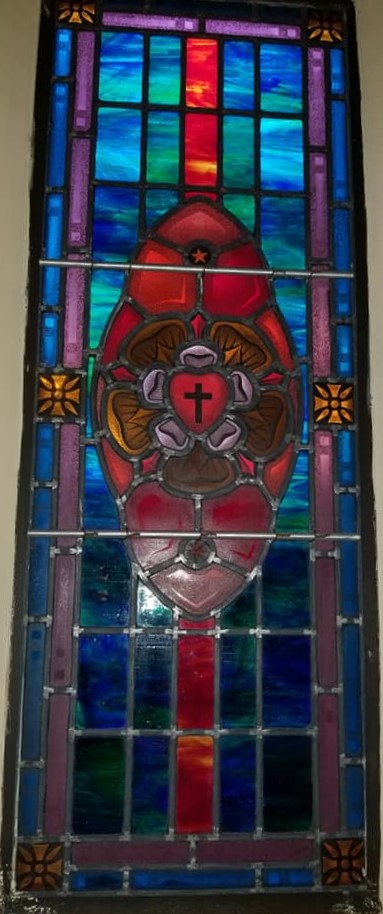
The Martin Luther Seal Window – represents our Great Reformer, Martin Luther by using a design based on Luther’s heraldry seal. A black cross on a red heart on a white rose surrounded by a blue sky and sometimes by a gold ring. However, this artist used a slightly different design. What does this mean? Please see the Martin Luther page for a more complete description of his seal. This window is on the west wall of the Sanctuary near the northwest exit door.
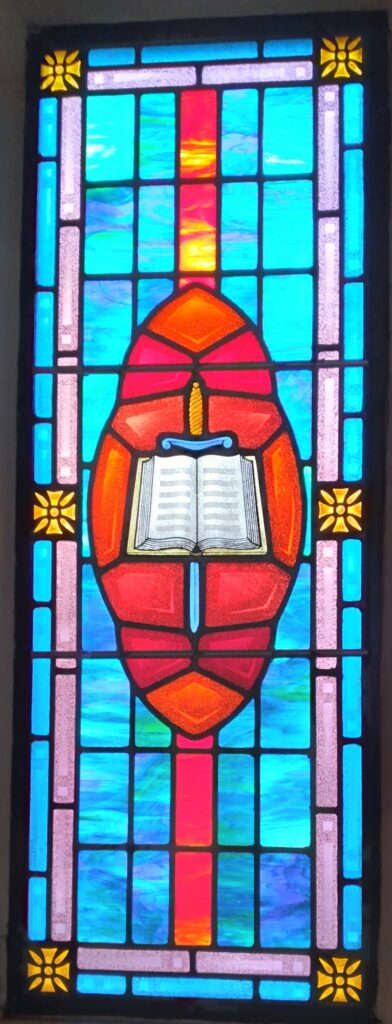
“The Saint Paul’s Epistles” Window – is a representation of an Open Bible. St. Paul is known for his many Epistles, letters he wrote to several churches in the Mediterranean area in the early days of the church to help set policy and resolve conflicts based on the teachings of Jesus Christ for his new church. It was St. Paul who helped solve the Galatian controversy by teaching that people did not need to be circumsized Jews in order to become Christians. It was also St. Paul who found a shrine to an “unknown God” in a Greek temple, and proclaimed this as Yahweh, the Creator of Heaven and Earth, the first person of the Blessed Trinity and the Father of Jesus.” And it was St. Paul who wrote the Book of Romans, which explains our sinfulness and need of God’s love and mercy, and St. Paul who wrote to the Corinthians telling them what love is

IHS Window in Narthex – respresents Jesus. IHS are the Greek letters for the Name Jesus. The beautiful window hangs in the Narthex so it can be seen when entering the church. On a bright sunny day, the window reflects some of our other windows as it hangs in the Sun. The Sun in this window respresents Jesus the Son of God. Jesus is the Light of the World.
Sources: Thank you Lisa Scopel for the wonderful photographs of the Christ Lutheran Church windows and Mildred Newton for the Biblical descriptions from your 2005 Church Scrapbook “Our Christian Art: Christ Lutheran Church” (Privately published). Additional material provided by Sharon Centanne, webmaster.


